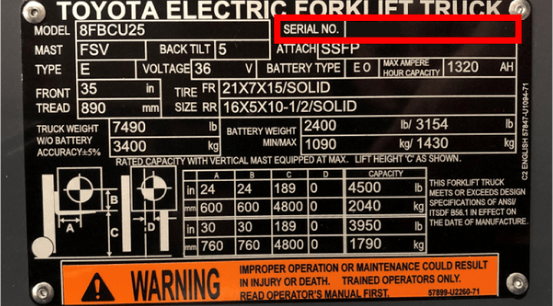Toyota SAS: Innovative Forklift Stability System

Forklift operator safety training is pivotal for ensuring safe, efficient operations. Unfortunately, even the most effective and reliable forklift operators can still find themselves in situations that put them at risk of tipovers and injury.
To help prevent these inevitable situations, Toyota has equipped most of our forklifts since 1999 with the patented System of Active Stability (SAS.) SAS is an efficient and effective forklift system that takes over 3,000 readings per second to detect unsafe operating conditions. If a safety hazard is detected, the SAS activates one of its two main features that improve lateral and longitudinal stability of the forklift.
Active Control Rear Stabilizer System
The Active Control Rear Stabilizer System uses a patented swing lock cylinder to increase lateral stability by locking the rear steer axle. By locking this in place, the forklift’s stability footprint is converted from its usual triangle to a rectangular pattern, reducing risks of a lateral tipover.

Active Mast Function Control System
When sensing risks for a longitudinal tipover, the Active Mast Function Controller System triggers forward tilt control or rear-tilt speed control.

When activated, the forward tilt control detects the load weight and the extended mast height. It then reduces the reverse tilt speed of the mast by half of its unrestricted speed.

The rear tilt speed control similarly detects the mast height and load weight to decrease the mast’s tilt speed, reducing chances of a load spilling or a reverse tipover.
Toyota’s SAS system is the first and only of its kind in the material handling industry. It has been accepted across the industry as one of the most important safety developments in material handling industry. That’s because Toyota SAS is key to protecting your most valuable assets – your operators.
Toyota SAS Protects Forklift Operators
Toyota engineers developed a dynamic forklift system for safety comprised of 10 sensors, 3 actuators, and a controller which protects the driver, load, and surrounding environment while facilitating efficient, productive material handling. System of Active Stability (SAS) works by continually monitoring the forklift’s operations and automatically taking protective action when needed.
This was all implemented on most Toyota forklifts in 1999 in order to protect operators in potentially hazardous situations. Here are some specific ways that that Toyota SAS forklift system help to protect operators.
- The Active Mast Control and Swing-Lock Cylinder functionalities exist as protectants for expertly trained operators. They add an additional layer of security that can increase safety when paired with proper forklift operation.
- Since transforming the safety triangle to a rectangle is not possible with a 3-wheel configuration, SAS takes a different approach to safeguarding stability of 3-wheel forklift models. Excessive speed when cornering is a leading risk factor for lateral tip-over accidents. The Speed Reduction When Cornering feature overrides manual controls by limiting the drive speed when cornering.
- Some of the most potentially dangerous forklift uses occur when a load is being moved at height. The front angle control helps protect against forward tip over and losing goods off the forks, causing them to fall. The read tilt speed control reduces the risk of dropped loads occurring when loads could potentials slip over the mast.
Operator protection is our number one concern at Toyota, which is why we invest so heavily in safety features for our Toyota forklifts.
Toyota SAS Myths Debunked
The System of Active Stability (SAS), which is unique to Toyota and comes standard on most Toyota forklifts, has been created to assist in safety. And with all systems that are exclusive and top of the line, investors in such technologies legitimately ask whether it’s really necessary and consider all possible problems. But the fact is Toyota SAS offers only benefits to the safety of your operators. To offer peace of mind, we can help to debunk some myths about Toyota SAS.
Myth #1: SAS causes forklift operators to drive unsafely.
Truth: Any properly trained forklift operator is capable of operating a forklift safely. Properly trained forklift operators understand that even with SAS, it’s important to operate the forklift safely.
Myth #2: SAS must be inspected every 40 hours.
Truth: SAS actually only requires a 30-second check every 250 hours.
Myth #3: SAS causes excess downtime.
Truth: There are 200,000 forklifts with SAS today and according to studies, those units have 99.7 percent up-time.
Myth #4: There are 3,000 sensors in the SAS.
Truth: There are only 14 sensors in the SAS. Those 14 sensors automatically monitor the forklift 3,000 times per minute.
The benefit of Toyota SAS is just one reason why Toyota continues to be an industry leader in material handling safety. Need more reason to invest in Toyota SAS? There are clear financial benefits as well.
Toyota SAS Offers Positive Financial Implications
The benefits of Toyota SAS extends to the balance sheet, as the overall cost of a forklift accident far outweighs the upfront expenditure for a Toyota and the minimal cost of maintenance. How minimal is that maintenance cost? SAS requires little-to-no maintenance. In fact, of all the SAS systems on forklifts in the field, the average cost of maintenance per year is around $17.
Now, compare that to the cost of a tip over…
SAS helps prevent accidents from happening due to an unstable forklift. If it were able to prevent just one accident, it would pay for itself one-thousand times or more. That’s huge.
At $17 per year, SAS is the best (and probably most economical) decision you can make for your business. And since the forklift system is exclusive to Toyota, that’s just one more reason to make your material handling fleet a Toyota fleet.
For more information about Toyota SAS or to request a quote, please contact your locally authorized Toyota dealer.


